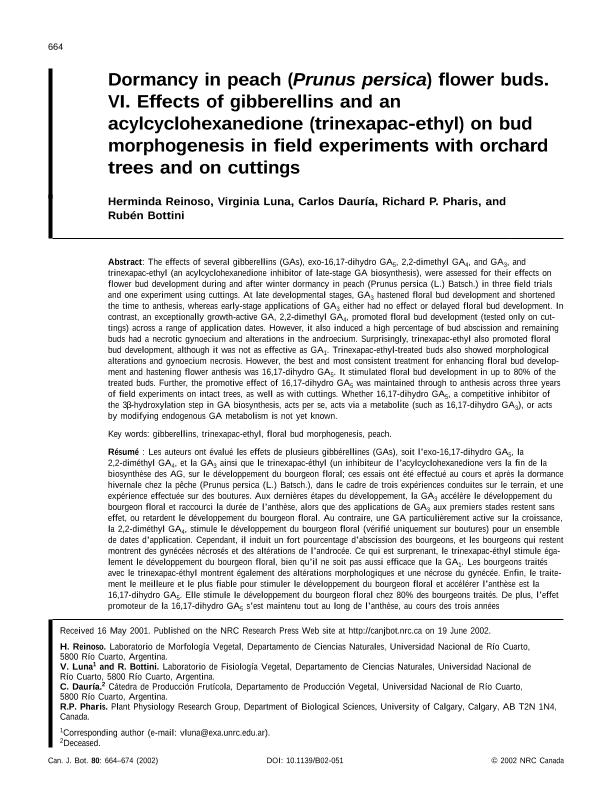Mostrar el registro sencillo del ítem
dc.contributor.author
Reinoso, Herminda
dc.contributor.author
Luna, Virginia
dc.contributor.author
Dauría, Carlos
dc.contributor.author
Pharis, Richard P.
dc.contributor.author
Bottini, Ambrosio Ruben

dc.date.available
2022-07-01T03:08:24Z
dc.date.issued
2002-10
dc.identifier.citation
Reinoso, Herminda; Luna, Virginia; Dauría, Carlos; Pharis, Richard P.; Bottini, Ambrosio Ruben; Dormancy in peach (Prunus persica) flower buds. VI. Effects of gibberellins and an acylcyclohexanedione (trinexapac-ethyl) on bud morphogenesis in field experiments with orchard trees and on cuttings; Canadian Science Publishing; Canadian Journal Of Botany; 80; 6; 10-2002; 664-674
dc.identifier.issn
0008-4026
dc.identifier.uri
http://hdl.handle.net/11336/161002
dc.description.abstract
The effects of several gibberellins (GAs), exo-16,17-dihydro GA5, 2,2-dimethyl GA4, and GA3, and trinexapac-ethyl (an acylcyclohexanedione inhibitor of late-stage GA biosynthesis), were assessed for their effects on flower bud development during and after winter dormancy in peach (Prunus persica (L.) Batsch.) in three field trials and one experiment using cuttings. At late developmental stages, GA3 hastened floral bud development and shortened the time to anthesis, whereas early-stage applications of GA3 either had no effect or delayed floral bud development. In contrast, an exceptionally growth-active GA, 2,2-dimethyl GA4, promoted floral bud development (tested only on cuttings) across a range of application dates. However, it also induced a high percentage of bud abscission and remaining buds had a necrotic gynoecium and alterations in the androecium. Surprisingly, trinexapac-ethyl also promoted floral bud development, although it was not as effective as GA1. Trinexapac-ethyl-treated buds also showed morphological alterations and gynoecium necrosis. However, the best and most consistent treatment for enhancing floral bud development and hastening flower anthesis was 16,17-dihydro GA5. It stimulated floral bud development in up to 80% of the treated buds. Further, the promotive effect of 16,17-dihydro GA5 was maintained through to anthesis across three years of field experiments on intact trees, as well as with cuttings. Whether 16,17-dihydro GA5, a competitive inhibitor of the 3β-hydroxylation step in GA biosynthesis, acts per se, acts via a metabolite (such as 16,17-dihydro GA3), or acts by modifying endogenous GA metabolism is not yet known.
dc.description.abstract
Les auteurs ont évalué les effets de plusieurs gibbérellines (GAs), soit l’exo-16,17-dihydro GA5, la 2,2-diméthyl GA4, et la GA3 ainsi que le trinexapac-éthyl (un inhibiteur de l’acylcyclohexanedione vers la fin de la biosynthèse des AG, sur le développement du bourgeon floral; ces essais ont été effectué au cours et après la dormance hivernale chez la pêche (Prunus persica (L.) Batsch.), dans le cadre de trois expériences conduites sur le terrain, et une expérience effectuée sur des boutures. Aux dernières étapes du développement, la GA3 accélère le développement du bourgeon floral et raccourci la durée de l’anthèse, alors que des applications de GA3 aux premiers stades restent sans effet, ou retardent le développement du bourgeon floral. Au contraire, une GA particulièrement active sur la croissance, la 2,2-diméthyl GA4, stimule le développement du bourgeon floral (vérifié uniquement sur boutures) pour un ensemble de dates d’application. Cependant, il induit un fort pourcentage d’abscission des bourgeons, et les bourgeons qui restent montrent des gynécées nécrosés et des altérations de l’androcée. Ce qui est surprenant, le trinexapac-éthyl stimule également le développement du bourgeon floral, bien qu’il ne soit pas aussi efficace que la GA1. Les bourgeons traités avec le trinexapac-éthyl montrent également des altérations morphologiques et une nécrose du gynécée. Enfin, le traitement le meilleure et le plus fiable pour stimuler le développement du bourgeon floral et accélérer l’anthèse est la 16,17-dihydro GA5. Elle stimule le développement du bourgeon floral chez 80% des bourgeons traités. De plus, l’effet promoteur de la 16,17-dihydro GA5 s’est maintenu tout au long de l’anthèse, au cours des trois années d’expérimentation sur le terrain portant sur des arbres intacts, aussi bien que sur des boutures. On ne sait pas si la 16,17-dihydro GA5, un inhibiteur compétitif de l’étape 3β-hydroxylation lors de la synthèse des GA, agit en soi, agit via un métabolite (tel que la 16,17-dihydro GA3) ou encore agit en modifiant le métabolisme endogène des GA.
dc.format
application/pdf
dc.language.iso
eng
dc.publisher
Canadian Science Publishing
dc.rights
info:eu-repo/semantics/openAccess
dc.rights.uri
https://creativecommons.org/licenses/by-nc-sa/2.5/ar/
dc.subject
FLORAL BUD MORPHOGENESIS
dc.subject
GIBBERELLINS
dc.subject
PEACH
dc.subject
TRINEXAPAC-ETHYL
dc.subject.classification
Ciencias de las Plantas, Botánica

dc.subject.classification
Ciencias Biológicas

dc.subject.classification
CIENCIAS NATURALES Y EXACTAS

dc.title
Dormancy in peach (Prunus persica) flower buds. VI. Effects of gibberellins and an acylcyclohexanedione (trinexapac-ethyl) on bud morphogenesis in field experiments with orchard trees and on cuttings
dc.type
info:eu-repo/semantics/article
dc.type
info:ar-repo/semantics/artículo
dc.type
info:eu-repo/semantics/publishedVersion
dc.date.updated
2020-08-04T19:40:39Z
dc.journal.volume
80
dc.journal.number
6
dc.journal.pagination
664-674
dc.journal.pais
Canadá

dc.description.fil
Fil: Reinoso, Herminda. Universidad Nacional de Río Cuarto. Facultad de Ciencias Exactas Fisicoquímicas y Naturales. Departamento de Ciencias Naturales. Área Morfología Vegetal; Argentina
dc.description.fil
Fil: Luna, Virginia. Universidad Nacional de Río Cuarto. Facultad de Ciencias Exactas Fisicoquímicas y Naturales. Departamento de Biología Molecular. Laboratorio de Fisiología Vegetal; Argentina
dc.description.fil
Fil: Dauría, Carlos. Universidad Nacional de Rio Cuarto. Facultad de Agronomia y Veterinaria. Departamento de Producción Vegetal; Argentina
dc.description.fil
Fil: Pharis, Richard P.. University of Calgary; Canadá
dc.description.fil
Fil: Bottini, Ambrosio Ruben. Universidad Nacional de Río Cuarto. Facultad de Ciencias Exactas Fisicoquímicas y Naturales. Departamento de Biología Molecular. Laboratorio de Fisiología Vegetal; Argentina. Consejo Nacional de Investigaciones Científicas y Técnicas. Centro Científico Tecnológico Conicet - Córdoba; Argentina
dc.journal.title
Canadian Journal Of Botany

dc.relation.alternativeid
info:eu-repo/semantics/altIdentifier/url/https://cdnsciencepub.com/doi/10.1139/b02-051
dc.relation.alternativeid
info:eu-repo/semantics/altIdentifier/doi/http://dx.doi.org/10.1139/b02-051
Archivos asociados
